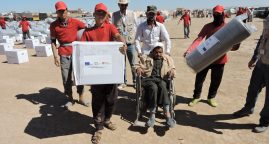UNITAR and OHCHR Set the Stage for More Satellite to Protect Human Rights
The United Nations Office of the High Commissioner for Human Rights (OHCHR) and UNITAR signed a milestone MoU that will allow greater use of UNOSAT imagery analysis and technical assistance in support to the Office’s human rights work. Through the agreement OHCHR will benefit from the latest geographic information technologies and the entire suite of geo-spatial solutions provided by UNITAR’s Operational Satellite Applications Programme (UNOSAT), including rush satellite imagery analysis, field data collection, mapping, data management and training.
“This technology is very important for the work we do. Indeed, UNOSAT analysis can prove very useful in complementing the various forms of human rights investigations we are called upon to conduct.”said OHCHR’s Deputy High Commissioner Flavia Pansieri who signed the agreement together with UNITAR Executive Director Sally Fegan-Wyles.
Under the agreement UNOSAT will provide its technical expertise and services to support ongoing emergencies, as well as preparedness, early warning and early action. The MoU paves the way for further mainstreaming satellite imagery analysis into the work of OHCHR, as well as Commissions of Inquiry and Fact-Finding Missions, and comes after years of active collaboration between UNOSAT and OHCHR. UNITAR Research Director Francesco Pisano says: “this MoU comes at a perfect time when the advancement of imagery analysis and other geo-spatial technologies combined with an experienced team of analysts at UNOSAT can support new ways to focus satellite technologies on human rights, also as a cross-cutting theme in the new Post-2015 development agenda”. A point of view shared at OHCHR, where Andrew Palmer, head of the Early Warning and Information Support Unit, said that the agreement is “a way to expand the use of satellite imagery and GIS maps across OHCHR and to provide staff with the knowledge and skills to take full advantage of its potential”.
UNOSAT is known for its continuing effort to bring to the UN family innovative analysis and new solutions. UNOSAT manager Einar Bjorgo expects that this will be case also for the area of human rights. In addition, the new development agenda, due to be adopted by UN member states in September 2015, provides an ideal backdrop for technology research. Bjorgo says: “Given the SDGs focus on human rights, the work we do at UNOSAT is well suited to monitor indicators over time and to provide the UN with timely analysis on specific events. Our analyses focus on local situations, the resulting data and information can then be aggregated. The game-changing factor is the revolution in access to imagery over any place on Earth allowed by the scientific and commercial fleet of satellites available today. The scale of today’s data access is unprecedented and can support new imperatives such as the commitment to leave no one behind. Often our imagery analysis is a source of objective information during conflicts and other crises, a contribution to protecting the most vulnerable and documenting violations and abuses against those in greater need as assistance”.
Satellite Imagery helping to monitor cultural heritage sites under threat
Cultural heritage around the world suffers from intentional attacks, collateral damage, looting and the effects of natural disasters. Reaching affected sites and areas quickly to monitor the situation, plan for restoration and prevent further loss often proves very difficult.
Thanks to a partnership between UNESCO and the United Nations Institute for Training and Research (UNITAR), satellite images developed through UNITAR’s UNOSAT programme in 2015 have been contributing to the work of UNESCO and heritage experts to evaluate and protect sites in Iraq, Syria, Yemen and Nepal. A new UNESCO-UNITAR summary report demonstrates how satellite imagery analysis is an increasingly important tool for assessing potential damage to cultural heritage sites.
According to Francesco Bandarin, UNESCO Assistant Director-General for Culture, “monitoring cultural heritage in areas affected by conflict or natural disasters, including through the use of satellite imagery, is a critical step to start planning for recovery.”
For example, a “before and after” scenario elaborated in the report examines the archaeological site of Nimrud, Iraq. Comparing UNOSAT satellite imagery from 18 April, 2015 to that of 7 March 2015, the extent and localization of damage and destruction inflicted by ISIS/Daesh upon the Palace of King Ashurnasirpal II (883-859 BC) becomes clear. In Nepal, following the 25 April 2015 earthquake, satellite imagery helped map which historic temples and monuments of Kathmandu were damaged and to what extent, and which were still intact. This allowed experts to better assess needs and plan reparation measures.
“These are good examples of how innovative applications of satellite imagery and other geo-spatial technologies make a difference in the way the United Nations supports its member states,” says Einar Bjorgo, Manager of UNOSAT.
To go further
More satellite images to assist human rights work
United Nations Institute for Training and Research Strategic Framework 2014 – 2017
How Geographic Information Systems (GIS) Can Help Tackle Global Challenges
Related Articles
NGOs and the private sector : the state as an arbitrator ?
March 2018. A complet brief published on Humanitarian Alternatives website.
Malteser International | Iraq: distribution of emergency kits for displaced people
06/06/2017. Distribution of emergency kits for displaced people
Holy Family Hospital in Bethlehem intensifies antenatal checks with awareness campaigns in the region
03/01/2020. “We will double our efforts to reach women wherever they might be”.






